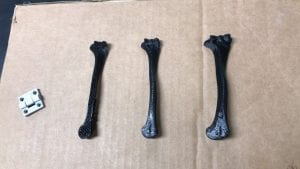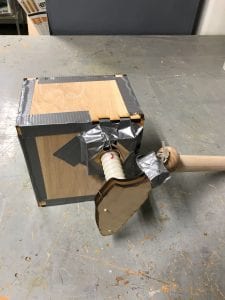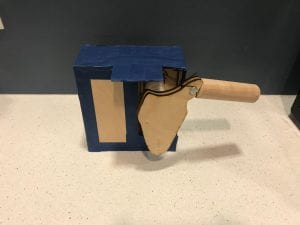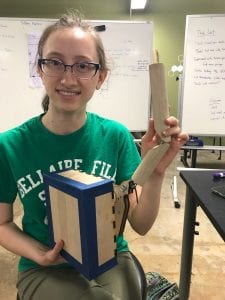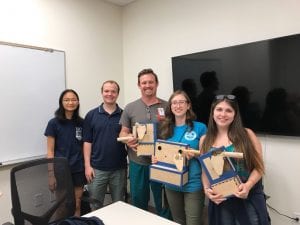Week 5 has been exhausting. Turns out prototyping is wildly unpredictable. On Friday our magnets came in which was exciting! Unfortunately, we managed to break one of them in the first few minutes of prototyping. So much for that train of thought. It turns out magnets are extremely brittle! We tried implementing some magnets from the OEDK but they proved to be too weak and ineffective. Instead, we decided to table that idea and look into 3D printing. We first tried scaling an adult humerus to the size of an infant. Amazingly, infants actually have bones that are nearly as thick as adult bones so when we uniformly scaled down the adult bone it just looked wrong. Everyone kept thinking we had printed a chicken bone. We tried scaling out the width and tabling the idea for Monday.
Monday brought a lot of change. Dr. Wettergreen returned from Malawi and brought a whole slew of new ideas with him. He came group to group and gave some (sometimes forceful) advice on how to improve or change some ideas. for us that sadly meant abandoning our scary black chicken bones and moving away from the brittle magnets. On top of that he gave us a challenge. He wanted to see a decent low-medium fidelity prototype by the next morning. We naturally were slightly overwhelmed. After spending days developing a concept and plan, Dr. Wettergreen and Dr. Hunter had advised us to not only change course, but complete a prototype of a new idea in about 3 hours. That was one heck of a panic. We reevaluated methodologies and quickly decided to go with a plan similar to a doll with an internal string. We spent the rest of the day rapidly cutting, drilling, gluing and tying till we had a semblance of a model. The results were not pretty, but did successfully demonstrate a concept. Despite a fair amount of panic and frustration, I have to give Dr. Wettergreen and Dr. Hunter credit, they did get us moving out of a material-waiting rut.
Tuesday morning we presented the quick model we had developed. Naturally we were a little concerned with the outcomes. Dr. Hunter and Dr. Wettergreen asked us to stay after the meeting to discuss it. They proceeded to guide us through the process of critiquing the model. The process was admittedly painful and my teammates and I were rather high strung by the end of the encounter. We did leave with some clear ideas for improvement though. A big takeaway from that was not to get emotionally attached to your work cause you may be asked to rip it apart the next day. Going forward we decided to model both the shoulder types at a larger size. We put a high priority on making stronger rotating connections for the scapulas because the old model had proven slightly week. We also begin developing the details of how to show a contracted arm versus a normal arm. We settled on just bolting the contracted arm to the scapula and making it fused. This demonstrated the motion nicely. The loose arm we went with a tied theraband strip although we have been discovering that is slightly too loose. By the end of the day we had mostly developed the next iteration of the model.
Wednesday we finished the rest of the model and begin developing a away to combine both shoulders onto one model. We spent hours establishing Adobe Illustrator files that would capture all the details we want. We decided to add a couple of dowels that would limit the range of motion of the shoulder because Dr. Hunter expressed concern that a shoulder would be disturbing if it could rotate 360 degrees. At the end of the day we used the laser cutter for almost 45 minutes to bring all of our carefully planned designs to fruition. We definitively were ahead of ourselves because yet again, the design was destined to change. In order to better demonstrate the joints we are now trying to implement a torsion spring as the connection point which is exciting!
Thursday morning was another honest appraisal of where our models stood. There were several suggestions on improvements from the professors that the team was less than sure about. We are a bit torn on changing things such as how far the scapula is from the rib cage. Fortunately we had scheduled a client meeting with James so we had the perfect source to work out details with. We spent the morning developing questions and putting finishing touches on models and then prepared to meet James. In the afternoon we walked over to the BRC (Bioscience Research Collaborative) to meet. The meeting was the ebsat decision our team could have made. We spoke with James for an hour and a half and established what was good and what needed improvement on our models. He was actually far more pleased than any of us had expected him to be which was very reassuring after all the set backs we had encountered. He made several shocking decisions such as not wanting the dowels to limit the scapula rotation and changing the orientation of how he would use the model. We left the BRC invigorated and excited to tweak the models to satisfy him and things are looking brighter than they were!
I would like to say that despite the fact this may read with a negative tone, prototyping is not meant to be straightforward. We had some bad ideas and some good ideas and the professors, TA’s and fellow students are doing what they can to make the best results possible. This week may have been frustrating but that does not mean it was not enjoyable. Despite the fact we seemed to be moving one step forward and then two steps back we did manage to create a prototype that made our client excited and I suppose that is what counts.

